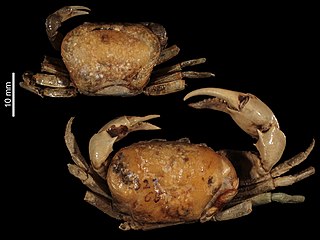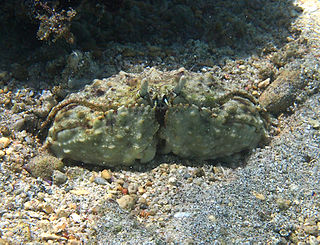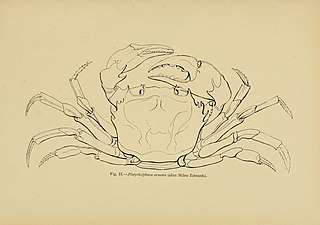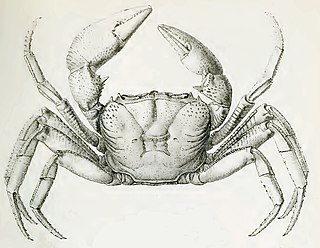
A fiddler crab, sometimes known as a calling crab, may be any of more than one hundred species of semiterrestrial marine crabs in the family Ocypodidae. A smaller number of ghost crab and mangrove crab species are also found in the family Ocypodidae. This entire group is composed of small crabs, the largest being slightly over two inches (5 cm) across. Fiddler crabs are found along sea beaches and brackish intertidal mud flats, lagoons and swamps. Fiddler crabs are most well known for their sexually dimorphic claws; the males' major claw is much larger than the minor claw, while the females' claws are both the same size.

Xanthidae is a family of crabs known as gorilla crabs, mud crabs, pebble crabs or rubble crabs. Xanthid crabs are often brightly coloured and are highly poisonous, containing toxins which are not destroyed by cooking and for which no antidote is known. The toxins are similar to the tetrodotoxin and saxitoxin produced by puffer fish, and may be produced by bacteria in the genus Vibrio living in symbiosis with the crabs, mostly V. alginolyticus and V. parahaemolyticus.

Libinia is a genus of crabs in the family Epialtidae, containing twelve extant species:

Austrothelphusa is a genus of freshwater crab endemic to Australia, comprising the following species:

Clibanarius is a genus of hermit crabs in the family Diogenidae. Like other hermit crabs, their abdomen is soft-shelled and sheltered in a gastropod shell. Typically marine like all their relatives, the genus includes C. fonticola, the only known hermit crab species that spends all its life in freshwater. The feeding rates of Clibanarius spp. change with temperature which, given their broad distributions, may have considerable consequences for the stability reef systems as sea temperatures rise in the future.

Calappa is a genus of crabs known commonly as box crabs or shame-faced crabs. The name box crab comes from their distinctly bulky carapace, and the name shame-faced is from anthropomorphising the way the crab's chelae (claws) fold up and cover its face, as if it were hiding its face in shame.
Afrithelphusa is a genus of freshwater crabs in the family Potamonautidae. It contains four species, all of which were formerly listed as critically endangered by the International Union for Conservation of Nature (IUCN). They are all endemic to the Upper Guinean forests of Guinea and Sierra Leone.

Platythelphusa is a genus of freshwater crabs endemic to Lake Tanganyika. It has been placed in a number of families, including a monotypic family, Platythelphusidae, as well as Potamidae and its current position in the Potamonautidae, and has also been treated as a subgenus of Potamonautes. It forms a monophyletic group, possibly nested within the genus Potamonautes, which would therefore be paraphyletic. The genus is the only evolutionary radiation of crabs to have occurred in a freshwater lake, and it occurred recently, probably since the Pliocene. This parallels the better known radiation of cichlid fishes in Lake Tanganyika. Only one other species of freshwater crab is found in Lake Tanganyika, Potamonautes platynotus.

Potamonautes lirrangensis, the Malawi blue crab, is a species of freshwater crab in the family Potamonautidae. This common and widespread species is found in Lake Malawi, Lake Kivu, the upper Congo River Basin and Malagarasi River in the Democratic Republic of the Congo, Malawi, Rwanda, and Tanzania. In the freshwater aquarium trade it is sometimes sold under the synonym Potamonautes orbitospinus.
Potamonautes mutandensis is an endangered species of freshwater crab in the family Potamonautidae. It is found in Lake Mutanda and Lake Kivu in Uganda, Rwanda and DR Congo.
Potamonautes niloticus is a species of freshwater crab in the family Potamonautidae. It is found in the Nile Basin in Egypt, Ethiopia, Rwanda, Sudan, and Uganda. Numerous specimens of P. niloticus are known from Miocene deposits around Lake Albert.
Potamonautes platycentron is a species of freshwater crab in the family Potamonautidae, which is endemic to Lake Chala in Kenya and Tanzania. It was originally described by Franz Martin Hilgendorf in 1897, as Telphusa platycentron.
Potamonautes raybouldi is a species of freshwater crab. It lives in water-filled tree holes in forests in the eastern Usambara Mountains of Tanzania and the Shimba Hills in Kenya. It is threatened by deforestation resulting from the expansion of the human population, and is listed as a vulnerable species on the IUCN Red List. The species was described in 2004, and named after Professor John N. Raybould of the University of Bristol, who collected the first specimens of the species.

Potamonautidae is a family of freshwater crabs endemic to Africa, including the islands of Madagascar, the Seychelles, Zanzibar, Mafia, Pemba, Bioko, São Tomé, Príncipe and Sherbro Island. It comprises 18 extant genera and 138 extant species. Fossil remains dating from the Late Miocene period have been attributed to the family Potamonautidae.

Trichodactylidae is a family of crabs, in its own superfamily, Trichodactyloidea. They are all freshwater animals from Central and South America, including some offshore islands, such as Ilhabela, São Paulo. Only one of the 50 species is known from the fossil record, Sylviocarcinus piriformis from the Miocene of Colombia. The family contains 15 genera in two subfamilies:

Potamonautes sidneyi is a species of freshwater crab in the family Potamonautidae. The common name is the Natal river crab or Sidney's river crab, although they may also be referred to as "river crabs", "fresh water crabs" or "land crabs".

Around 1,300 species of freshwater crabs are distributed throughout the tropics and subtropics, divided among eight families. They show direct development and maternal care of a small number of offspring, in contrast to marine crabs, which release thousands of planktonic larvae. This limits the dispersal abilities of freshwater crabs, so they tend to be endemic to small areas. As a result, a large proportion are threatened with extinction.

Seychellum alluaudi is a species of freshwater crab endemic to the Seychelles, and the only true freshwater crab in that country. It lives in rainforest streams on the archipelago's granitic high islands. Although it may be abundant, little is known about its biology. If its habitat were to decline in quality, S. alluaudi might become endangered, but it is currently listed as Vulnerable on the IUCN Red List.

Pilumnus is a genus of crabs, containing the following species:














